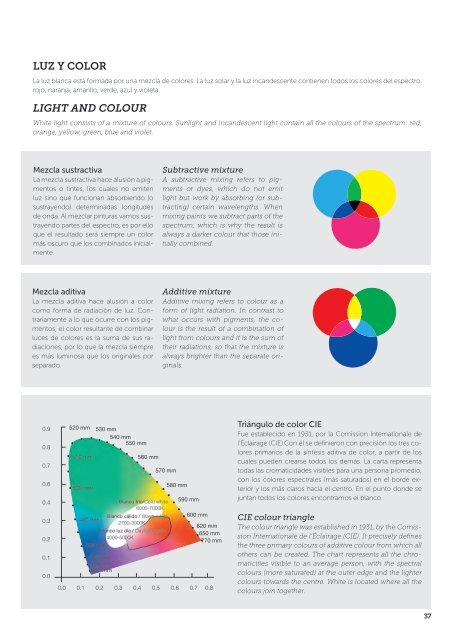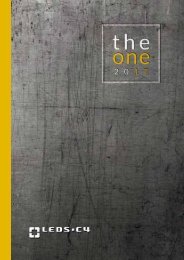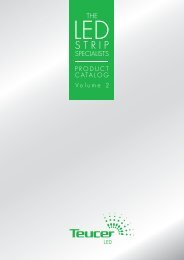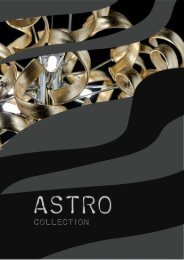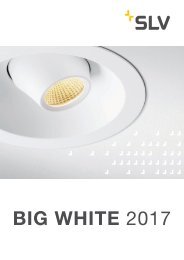RETAIL_2016
You also want an ePaper? Increase the reach of your titles
YUMPU automatically turns print PDFs into web optimized ePapers that Google loves.
LUZ Y COLOR<br />
La luz blanca está formada por una mezcla de colores. La luz solar y la luz incandescente contienen todos los colores del espectro:<br />
rojo, naranja, amarillo, verde, azul y violeta.<br />
LIGHT AND COLOUR<br />
White light consists of a mixture of colours. Sunlight and incandescent light contain all the colours of the spectrum: red,<br />
orange, yellow, green, blue and violet.<br />
Mezcla sustractiva<br />
La mezcla sustractiva hace alusión a pigmentos<br />
o tintes, los cuales no emiten<br />
luz sino que funcionan absorbiendo (o<br />
sustrayendo) determinadas longitudes<br />
de onda. Al mezclar pinturas vamos sustrayendo<br />
partes del espectro, es por ello<br />
que el resultado será siempre un color<br />
más oscuro que los combinados inicialmente.<br />
Subtractive mixture<br />
A subtractive mixing refers to pigments<br />
or dyes, which do not emit<br />
light but work by absorbing (or subtracting)<br />
certain wavelengths. When<br />
mixing paints we subtract parts of the<br />
spectrum, which is why the result is<br />
always a darker colour that those initially<br />
combined.<br />
Mezcla aditiva<br />
La mezcla aditiva hace alusión a color<br />
como forma de radiación de luz. Contrariamente<br />
a lo que ocurre con los pigmentos,<br />
el color resultante de combinar<br />
luces de colores es la suma de sus radiaciones,<br />
por lo que la mezcla siempre<br />
es más luminosa que los originales por<br />
separado.<br />
Additive mixture<br />
Additive mixing refers to colour as a<br />
form of light radiation. In contrast to<br />
what occurs with pigments, the colour<br />
is the result of a combination of<br />
light from colours and it is the sum of<br />
their radiations, so that the mixture is<br />
always brighter than the separate originals.<br />
0.9<br />
0.8<br />
0.7<br />
0.6<br />
0.4<br />
0.3<br />
0.2<br />
0.1<br />
0.0<br />
0.0<br />
520 mm<br />
510 mm<br />
500 mm<br />
530 mm<br />
540 mm<br />
550 mm<br />
Blanco frío/Cold white<br />
6000-7000K<br />
Blanco cálido / Warm white<br />
490 mm<br />
2700-3000K<br />
Blanco luz día / Daylight white<br />
4000-5000K<br />
480 mm<br />
0.1<br />
470 mm<br />
450 mm<br />
380 mm<br />
0.2<br />
0.3<br />
0.4<br />
560 mm<br />
570 mm<br />
0.5<br />
580 mm<br />
0.6<br />
590 mm<br />
600 mm<br />
0.7<br />
620 mm<br />
650 mm<br />
770 mm<br />
0.8<br />
Triángulo de color CIE<br />
Fue establecido en 1931, por la Comission Internationale de<br />
l’Éclairage (CIE).Con él se definieron con precisión los tres colores<br />
primarios de la síntesis aditiva de color, a partir de los<br />
cuales pueden crearse todos los demás. La carta representa<br />
todas las cromaticidades visibles para una persona promedio,<br />
con los colores espectrales (más saturados) en el borde exterior<br />
y los más claros hacia el centro. En el punto donde se<br />
juntan todos los colores encontramos el blanco..<br />
CIE colour triangle<br />
The colour triangle was established in 1931, by the Comission<br />
Internationale de l’Éclairage (CIE). It precisely defines<br />
the three primary colours of additive colour from which all<br />
others can be created. The chart represents all the chromaticities<br />
visible to an average person, with the spectral<br />
colours (more saturated) at the outer edge and the lighter<br />
colours towards the centre. White is located where all the<br />
colours join together.<br />
37


